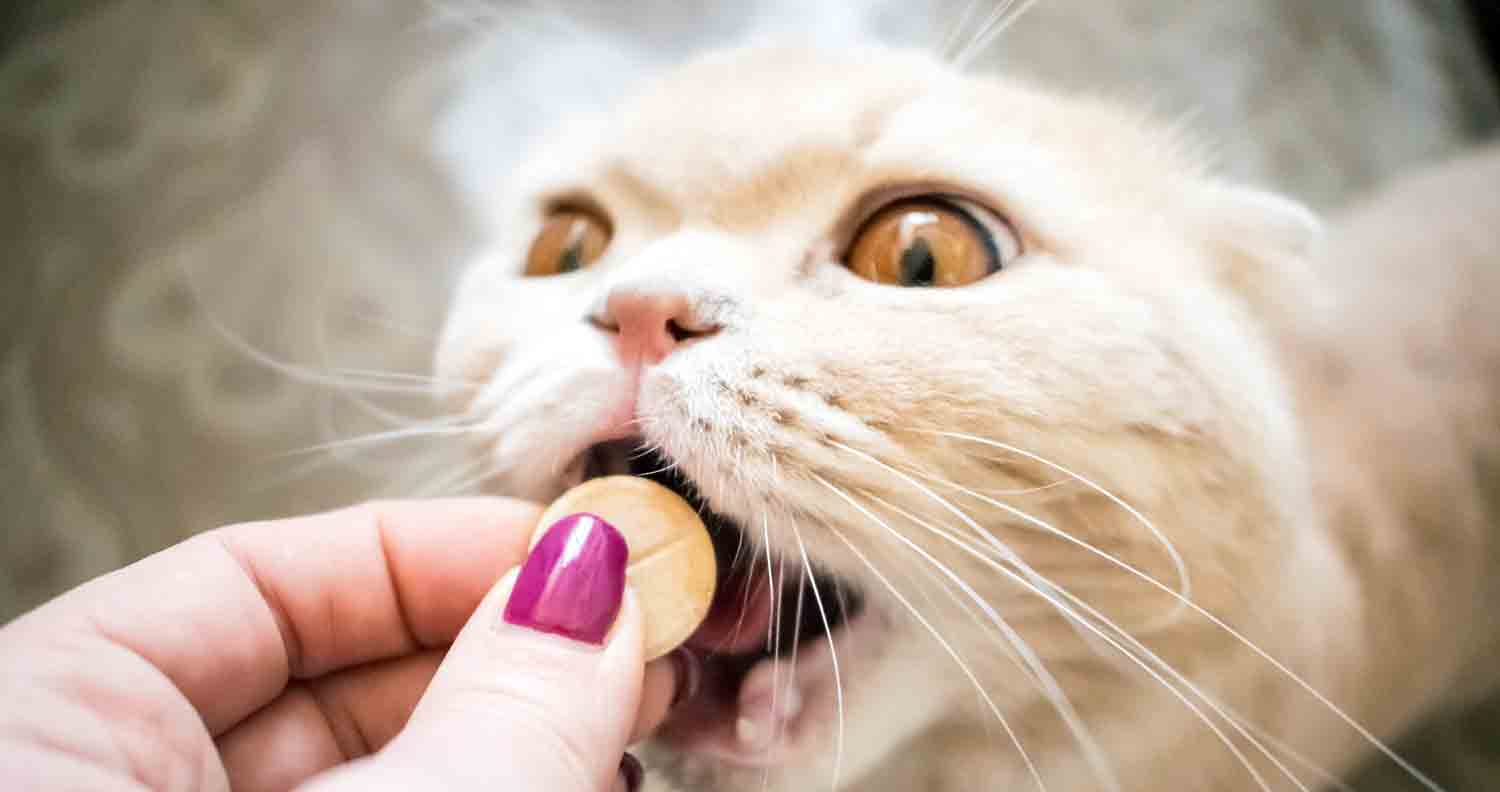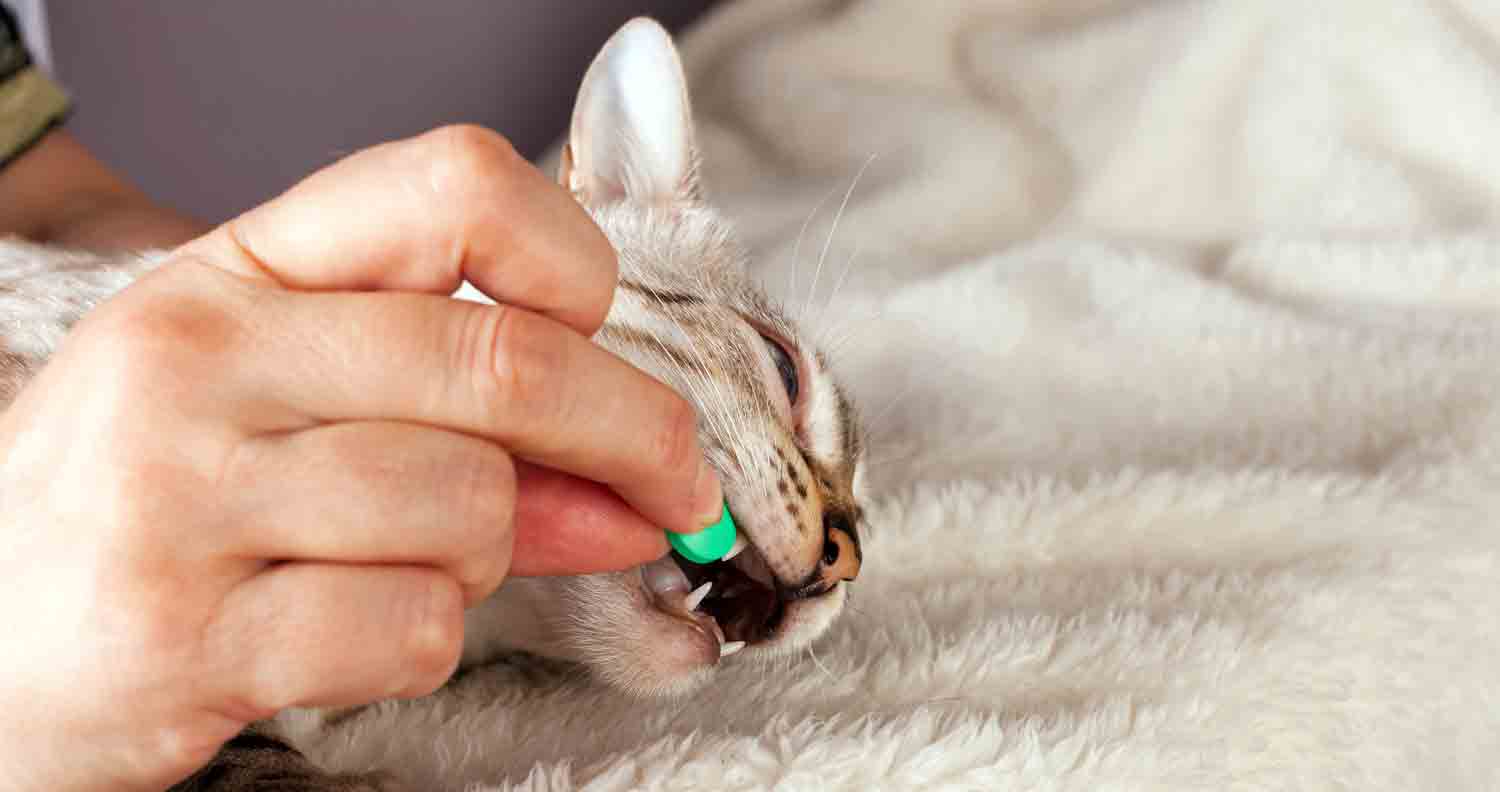How To Give Your Cat Medicine Properly!
Share:

Being sick is the worst. It’s tough for cats too and the last thing they want is for their human bugging them if. So knowing how to give your cat medicine properly is a big part of being a good “hooman”!
Your temperature’s constantly changing between hot and cold. You can’t enjoy your meals. Maybe you’re even struggling to get a good night’s sleep between periods of discomfort.
Just like you, your pets aren’t fond of being unwell. Unfortunately, unlike us, our cats don’t understand that they must take certain medications or pills to get better. That means that you must force them to take things they’d probably rather not eat.
Forcing your kitty to take medicine isn’t fun, and it can often make you feel like the worst person in the world. But despite all the hissing, scratching, and potential cat bites you know you’re doing what’s best for your furry friend.
The good news is that while giving cats medicine might not be easy, it also doesn’t have to be a nightmare. There are ways you can simplify the process of providing your pet with pills and liquid medications. Here are our top tips for how to give your cat medicine properly.
Before You Begin
Before you jump into the task of giving your furry friend medicine, the first step is making sure you know what you need to do. This means reading the instructions provided by your veterinarian carefully. Make sure you take the time to read all the information given to you by your vet. You’ll need to measure the amount of medicine to give your cat carefully, and ensure you’re spreading doses out appropriately.
Your instructions will also inform you of how you should be giving the medicine to your cat. While some pills can be mixed with foods, others will need to be given with water, or on their own to ensure the proper outcomes.
For the purpose of this guide, we’re going to be looking at some of the best ways to give your cat medicine in pill or liquid form. If you’re going to be using eye drops, ear drops, or injections with your feline, then you’ll need to follow some slightly different guidelines (we’ll cover those at the bottom of the article).
Before you begin medicating your cat:

7 Ways to Give Your Cat Medicine
Now that you know some of the basics of giving your cat medicine, it’s time to explore some of your options. We’ve got a few suggestions here, but keep in mind that you might also discover a new way of supporting your furry friend when you’re experimenting.
1. Manually Give the Medicine
The most obvious way to give your kitty medicine is to place the pill or liquid into his or her mouth manually. This might sound simple enough, but with sharp claws and teeth to worry about, it takes a lot of practice to become a pro at this method.
If you know that your kitty isn’t going to be fooled by any disguises or games intended to help them take their pills, then you’re going to have to get used to the manual administration method and for pills maybe consider a pilling device or dropper devices. Start by wearing your cat out with some play, so they’re less pent up with energy. A little bit of running after a toy kitty mouse can put your feline friend in a better mood.
After he or she has calmed down and begun to relax from the play, then you can carefully collect your cat and hold them close to you on your lap or a hard surface. Some cats don’t like being held, while others are very fond of it. If your cat is unhappy with being picked up, try wrapping them in a towel or blanket to keep their legs close to their body, and avoid any claws.
Once you’ve got your cat held close, take your thumb and index finger, and use them to open your cat’s mouth, carefully prying apart the teeth. Place the pill far into the corner of the mouth, under the cat's tongue. You can also squirt liquid medicine towards the back of their throat. Hold your cat close, and gently rub his or her throat with your fingers in a downwards motion to help them swallow.
Once you’re sure that your cat has swallowed the medicine, you can let them go. They might need some time on their own after that stressful experience, but treats can be a great way to get them feeling happy again. Make sure that there is plenty of fresh water available to wash the pill down too.
Check out our full article on how to give a cat a pill here.
2. Hide the Pill in a Meal
One of the easiest ways to give medicine to cats is to hide it in their food, so they’re less likely to notice they’re being given anything. If you’re giving liquid medicine, you can simply squirt it on top of the cat food and mix it in.
Make sure that the meal you’re giving has a strong enough smell, like tuna, to disguise the scent of the medicine. If you’re using a capsule or tablet, you may be able to break it up or take the capsule apart to get the medicine within. This makes it a little easier to mix the medicine with some of their favourite wet cat food.
The key to success when hiding medicine in foods is making sure that your cat has an empty stomach, is hungry, and is ready to eat. Giving your cat a pill in their food when you usually feed them each morning means that they’ll be more likely to start eating without any suspicion. However, there’s always a risk that your cat will simply eat around the medicine, or only consume a little bit of it.

Get 30% off and FREE shipping on cat food!
U.S.A. only
To Find out why we recommend chewy.com, click here
If your cat doesn’t finish their meal, you may have to recover the rest of the pill or find another way to provide the remaining medicine. Remember, a standard meal might not be enough to entice your kitty to eat their medicated food. You might need to consider giving them treats instead that will make them more likely to pay attention.
3. Disguise the Medicine with Treats
Hiding a pill in a small amount of cheese or fresh fish could be an excellent way to encourage positive results. Many cats will be so delighted by the idea of a treat that they’ll swallow the food before they notice the pill. Of course, it’s important to choose the right treats to disguise the medicine. A little bit of cat food gravy or some lactose-free cream cheese could be an excellent choice for a cat liquid medication. Make sure you give your cat some of the treats without the medicine in it first. This will make them more likely to continue taking the treat.
Avoid crushing the pills that your vet gives you for your cat to mix them with liquid food if you can. Not all pills are suitable for crushing, and some will taste even more bitter when your cat encounters them this way. Speak to your vet about the ideal way to administer medicine if you’re not sure.
Though crushing may not be an option, splitting the pill into two pieces so it’s easier to hide might be a good alternative. You could also consider hiding the pill in the “pill pockets” that you can find online and from pet stores. These pockets hide the medication completely, so your cat can’t smell it before they begin eating. Of course, there is a chance that once your furry friend does discover a pill, they’ll leave the pill pocket half-eaten on the floor.

4. Request Liquids over Pills
You can’t always choose what kind of medication you’ll get for your cat. However, if it’s possible to replace pills with liquids, you might want to consider this option. Although it can be very difficult to put a syringe in your cat’s mouth, it’s often much harder to convince them to not only take a pill but swallow it too.
With liquid, you only need to get the syringe into the cat’s mouth for a moment and squirt it into the back of their throat as quickly as possible. It’s much less likely that your cat will be able to spit up all of the liquid or throw it out of its mouth.
When using liquids, remember that most cats are more likely to accept medicine that’s at room temperature, rather than being ice cold. Don’t warm the medicine up, unless your vet tells you to do so, but keep it out of the fridge too.
If you’ve never given your cat a syringe before, you could consider practicing with water once or twice before you start with the medicine. This gives you a chance to see how the administration and the plunger device works while showing your cat that a syringe isn’t always a bad thing. Remember not to tilt your cat’s head back when giving the medicine, as this can cause your cat to inhale some of the liquid.
5. Try Catnip
We mentioned above that it can be helpful to wear your cat out with a little play before you start administrating medication. Giving your cat some exercise can reduce the risk that they’ll fight you when you come to them with medication. However, there are other things that you can do to put your kitty into a more susceptible mood for treatment.
For instance, use some catnip to provide your cat with a fun boost before you measure out the medication, or retrieve the pill. Your cat will be so busy enjoying the smell of the catnip, that they may be less likely to notice the medication.
Catnip is a great way to put your cat in a wonderful frame of mind. Just make sure that you’re don’t only provide catnip when medication is coming. If you preserve the nip only for the times when your cat is going to feel stressed or scared, then they’ll start to associate the smell with bad things. Have plenty of moments where you allow your cat to roll around in catnip or play with a catnip toy without any ulterior motives.
You could even use catnip licks to get your kitty into a great mood, then add a small amount of liquid medication onto the ball of nip to deliver the medication. You can deliver small doses at a time so your kitty is less likely to smell them.
6. Provide a Pamper Session
Your cat is going to be scared and upset when you give them medication. You’re forcing to do something that they don’t really want to do on their own. It’s important to remind your kitty of how much you love them with some pampering and affection both before and after the treat.
After playing with your cat to wear them out, give them a relaxing grooming session with their favorite brush, or simply pet them in the way that they enjoy most. A purring and happy cat is in a much better mood than your standard feline.
Remember, just like with the catnip suggestion, you’ll need to give your cat plenty of grooming sessions in between medication administrations too. This will ensure that your cat doesn’t begin to associate cuddles with you with scary experiences.
During the pamper session, when your cat is as relaxed as can be, and even practically falling asleep, use this as the moment to administer medicine as carefully as you can. Be gentle, and remember to follow up with plenty of extra pampering.
7. Get a Professional’s Help
If all of the suggestions above simply don’t work for you and your feline, there’s only one thing left to do. Go back to the vet. Some kitties are worse than others when it comes to taking medicine. If it gets to the point where you’re stressing your cat out to extreme levels every time you approach them with a pill or syringe, you’re going to need some expert advice.
Your vet might not be able to give every pill or dose for you, but they can at least give you some guidance on what you might be able to do differently. For the first dose of your cat’s medicine, it’s often a good idea to get some guidance from a vet anyway. This will make it easier for you to ensure that you’re delivering the medication correctly.
If you can’t get a vet to help you, then you may be able to get some advice from a groomer who has worked with your cat before. Remember, groomers know how to relax even the most stubborn of cats, so they might have some secrets to share.

What About Drops and Injections?
If the medicine you need to give your cat isn’t a cat oral medication liquid or a pill, then it’s crucial to follow your doctor’s instructions carefully. Generally, eye drops, and ear drops follow the same guidelines as manually administering pills or oral liquids. Unfortunately, you can’t “hide” these drops, but you can put your kitty in a good mood before giving them with things like catnip, treats, and pets.
If you can find a relaxation spray for cats online or in your local pet store, consider using this before medication sessions to see whether it makes a difference to your cat’s mood.
Remember, when giving drops, and injections, the most important thing is ensuring your cat stays still. A squirming cat could easily end up with a needle in the wrong place, or a drop that lands on the floor or their fur instead. Wrap your cat in a towel or blanket to stop them from squirming, then:
After Giving Your Cat Medication
Once you’ve successfully medicated your cat, the next step is simply to reassure and reward your cat. Make sure that he or she has somewhere safe to go if they’re feeling nervous, and don’t chase them around if they want to be on their own. If your cat appreciates cuddles, make sure that you provide plenty of warmth and affection.
Keep a close eye on your cat after providing medication so you can inform your vet if you notice any issues or side effects.

Get 30% off and FREE shipping on cat supplies!
U.S.A only
To Find out why we recommend chewy.com, click here
Affiliate disclosure : We Love Cats and Kittens is a participant in several affiliate programs including the Amazon Services LLC Associates Program, and the Chewy affiliate program. These are affiliate advertising programs designed to provide a means for sites to earn advertising fees by advertising and linking to products on their sites. If you click on links in our blog posts and articles we may be paid a commission.
Share:

